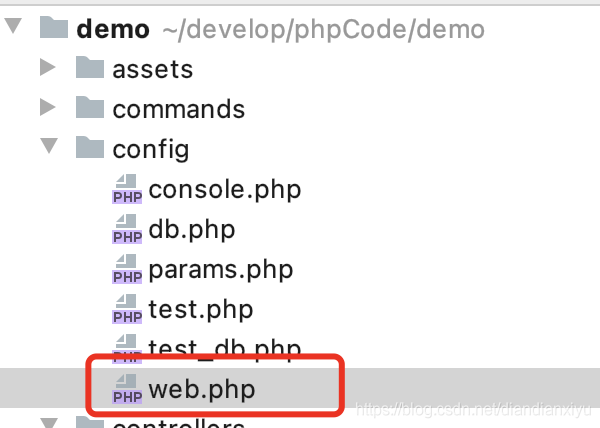什么是缓存组件Cache
缓存是提升 Web 应用性能简便有效的方式。 通过将相对静态的数据存储到缓存并在收到请求时取回缓存, 应用程序便节省了每次重新生成这些数据所需的时间。

Yii2的缓存是通过组件Component实现的,在项目的配置文件中,配置components->cache实现对缓存组件的定义。
项目配置文件的路径为config/web.php。

作为网站来讲,Yii2的页面缓存非常便捷地将已经渲染完全的网页结果保存起来,并在一个缓存周期内不需要再次处理页面内部的控制器动作逻辑。
配置页面缓存页面缓存的配置方式为,在控制器层Controller中配置行为behaviors,通过调用过滤器filters的方式,在进入具体页面路径action的之前,对当前key进行计算,并判断缓存是否启用enabled缓存有效期duration。
基础配置代码如下所示
return [ 'pageCache' => [ 'class' => 'yii\filters\PageCache', 'only' => ['index'], 'variations' => [ 'https://www.jb51.net/', Yii::$app->request->isAjax, ], 'enabled'=>true, 'duration' => Yii::$app->params['pageCacheDuration'], ], ];
过滤器是Yii2中的一个概念,他可以在控制器初始化的时候加载并执行,我们可以用这个特点去做一些对控制器的数据的限制,比如控制缓存、用户权限控制。
这里我们将行为名称定义为pageCache,显然名字不重要,因为有的案例中,因为不同的页面缓存规则不一样,我会定义两个页面缓存的行为。
其中only为过滤器调用action的参数,用于限制哪些路径是启用action的。
页面缓存PageCache是缓存组件Cache的一种应用页面缓存的根本逻辑为
配置缓存组件的实现比如文件缓存yii\caching\FileCache
页面缓存封装一层Cache组件,再去调用存取逻辑
我们可以通过查看页面缓存源码vendor/yiisoft/yii2/filters/PageCache.php,我们可以在文件的第162行发现,这里调用的cache,就是对于缓存的实现。
$this->cache = Instance::ensure($this->cache, 'yii\caching\CacheInterface');
自定义页面缓存过滤器为什么我们需要自定义缓存组件呢,我归纳原因存在以下几种
缓存判断逻辑过于简单或复杂,不如自己重写痛快地多
缓存key生成方式不满足业务需求
那么如何自定义呢?我个人推荐最简单粗暴的方式,继承。
use yii\filters\PageCache; class PageCacheCtInfo extends PageCache { 这里是内部逻辑,不需要重写的方法可以不写。 public $checkUser = true; //可以自定义变量 }
调用方式也是跟默认的页面缓存一样,只要换上对应的类即可。
'pageCacheInfo' => [ 'class' => 'common\components\PageCacheCtInfo', 'only' => ['info'], 'enabled'=>Yii::$app->params['pageCacheEnabled'], 'variations' => [ 'ct/'.Yii::$app->request->pathInfo, Yii::$app->request->isAjax ], 'duration' => Yii::$app->params['pageCacheInfo'], 'checkUser' = false, ],
页面缓存key的计算根据上一个步骤,我们可以重写计算key的方式,那么之前的key计算方式是什么样的呢?
文件位置vendor/yiisoft/yii2/filters/PageCache.php。
/** * @return array the key used to cache response properties. * @since 2.0.3 */ protected function calculateCacheKey() { $key = [__CLASS__]; if ($this->varyByRoute) { $key[] = Yii::$app->requestedRoute; } return array_merge($key, (array)$this->variations); }
这里的缓存key是一个数组,数组内的元素依次是
当前类名
varyByRoute 一般为true
variations 验证,这个也是配置中获取的,根据上面的配置,则是页面路径和是否为ajax
如果是项目的首页,缓存的key则为
['yii\filters\PageCache','','/‘,0]
如果是个详情页面,key为
['yii\filters\PageCach', 'xxx/info','xxx/xxx/3xxxx74.html',0 ]
那么,这个key到底有什么用,为什么要单独拿出来说呢?
因为我们需要单独删除某个页面缓存。
主动清理过期缓存根据源码vendor/yiisoft/yii2/caching/FileCache.php
/** * Stores a value identified by a key in cache. * This is the implementation of the method declared in the parent class. * * @param string $key the key identifying the value to be cached * @param string $value the value to be cached. Other types (If you have disabled [[serializer]]) unable to get is * correct in [[getValue()]]. * @param int $duration the number of seconds in which the cached value will expire. 0 means never expire. * @return bool true if the value is successfully stored into cache, false otherwise */ protected function setValue($key, $value, $duration) { $this->gc(); $cacheFile = $this->getCacheFile($key); if ($this->directoryLevel > 0) { @FileHelper::createDirectory(dirname($cacheFile), $this->dirMode, true); } // If ownership differs the touch call will fail, so we try to // rebuild the file from scratch by deleting it first // https://github.com/yiisoft/yii2/pull/16120 if (is_file($cacheFile) && function_exists('posix_geteuid') && fileowner($cacheFile) !== posix_geteuid()) { @unlink($cacheFile); } if (@file_put_contents($cacheFile, $value, LOCK_EX) !== false) { if ($this->fileMode !== null) { @chmod($cacheFile, $this->fileMode); } if ($duration <= 0) { $duration = 31536000; // 1 year } return @touch($cacheFile, $duration + time()); } $error = error_get_last(); Yii::warning("Unable to write cache file '{$cacheFile}': {$error['message']}", __METHOD__); return false; }
在设置缓存之前会主动调用清理缓存的方法gc()

